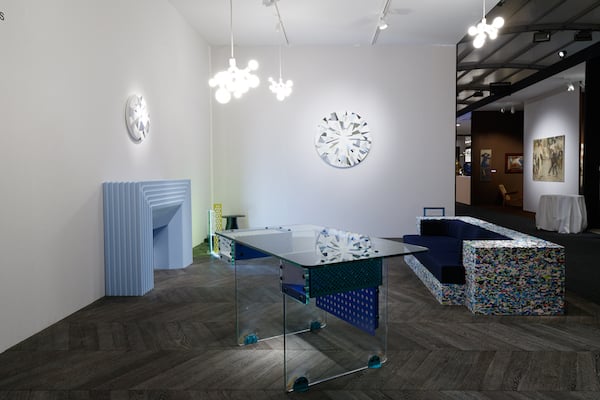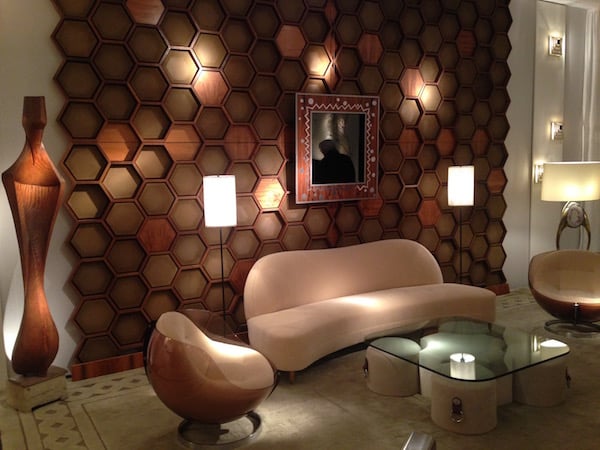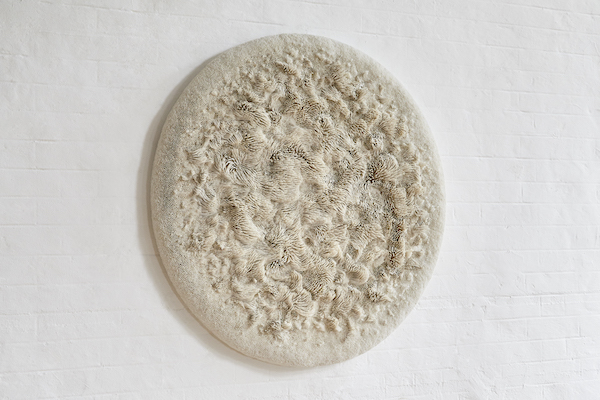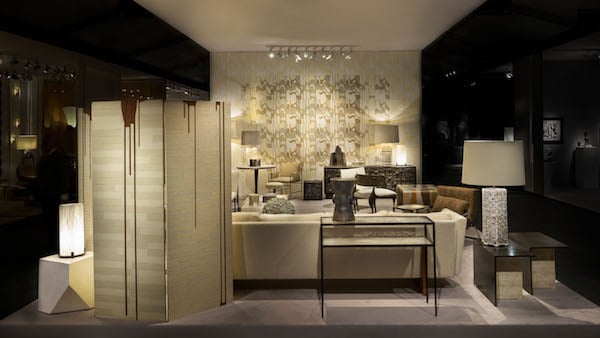Analysis
The 20th Edition of PAD Paris Delights yet Again
Organic textures are all the rage at the 2016 edition of the Parisian fair.

Photo: Courtesy of the gallery.
Organic textures are all the rage at the 2016 edition of the Parisian fair.

Emily Nathan

It’s springtime in Paris, and that means it’s time for international collectors of every ilk to flock to the Tuileries Garden for the 20th edition of Paris’ Pavilion of Art and Design fair, best known as PAD.
The 2016 edition of PAD continues its established history of eclecticism, with over 70 exhibitors presenting luxurious pieces of modern and contemporary art, new and vintage design, antiquities, and jewelry.
As is often the case, PAD is a markedly French affair, despite the global profile of its attendees. The majority of dealers hail from Paris, while the London scene is represented Rose Uniacke, Repetto Gallery, Gallery Fumi, and Aktis Gallery.
International appearances are also made by Modernity from Stockholm, Garrido from Madrid, Ammann Gallery from Cologne, Galerie Le Beau from Brussels, and Gerard Lasés, a Paris transplant currently based in Hong Kong. Show veterans include the likes of Jousse Entreprises and Galerie Alexandre Guillemain, while brand new additions include Paris dealers Armel Soyer and Perpitch & Bringand.
Entering the tent from the Rue de Rivoli, visitors are immediately greeted by a large tree made from painted black wood with shimmering golden leaves, a piece by contemporary Parisian atelier Stephane Chapelle, and its sets the tone for the natural textures and organic motifs that abound inside. Throughout the fair, artistry and surprising textures seem to be privileged over refined polish.

Booth of Galerie Hervouet at PAD Paris 2016.
Photo: Courtesy of the gallery.
“Trends go back and forth, I think,” said Jacques Hervouet, of the eponymous Paris gallery. “It’s very French, I think, to have all these beiges and grays combined with precious woods. But at PAD you see one of two things: you see a lot of craft, with natural materials like wood grain and leather, or you have the roaring 1960s and 70s look, with acrylics and plastics. Normally they’re not meant to be together, but we like to combine them,” he explained.
Perhaps no gallery at PAD embodies the “roaring 60s look” better than Torri Gallery, which dazzled with a pastel-blue chimney by Victoria Wilmotte, made from chalky Corian acrylic polymer, or a psychedelic, rainbow-hued, polyvinyl-foam sofa by Clémence Seilles, a graduate of London’s Royal College of Art.
At Gallery Fumi, meanwhile, earthy textures and colors abounded. A stunning, wall-mounted composition made entirely of shells by British artist Rowan Mersh evoked a piece of fur, or an expanse of soft feathers—and it was quickly sold for €40,000.

Work by Rowan Mersh at the booth of Gallery Fumi at PAD Paris 2016.
Photo: Courtesy of the gallery.
“Mersh started as a textile artist, and that’s visible in the movement and fluidity in his work, despite the hardness of the materials,” said Valerio Capo, co-director of the gallery. “That kind of craft is really what we do: you never see incredibly polished stuff here–all our pieces are made by designers in their studio.”
At ToolsGallerie, a cabinet with jutting contours by Boris Dinnler looked like a failed game of Jenga. Priced at €38,000, it quickly sold to the Victoria & Albert Museum in London. “This piece is very rare and expensive, but I also like to feature works that only look expensive,” gallery director Loïc Bigot said, pointing to a series of rubber sculptures by Pleunie Buyink, priced at €1,500-4,900 each. Shimmering against the wall, their interior layers of aluminum foil make them glisten and sparkle like precious gems.
At BSL gallery, forms got so organic that they verged on eyesore. Spanish artist Nacho Carbonell brought a series of Luciferase lamps made from silicon, resin and sand, priced between €6,000 and €19,000. With their grainy surfaces and strange colors, they evoke night creatures of the deep or stalactites—and the gallery had already sold a handful by noon on opening day. Hollow porcelain benches and stools by Djim Berger, meanwhile, looked like honeycomb or pumice stone. These too sold like hotcakes, a steal at €1,800-4,800.

Lamp by Nacho Carbonell at the stand of ToolsGallerie at PAD Paris 2016.
Photo: Courtesy of the gallery.
At James Gallery, sleek expanses of cherry wood were balanced by textures that recalled recycled paper–precisely because they were made exclusively from it. A series of stunning wall disks by Brazilian artist Domingos Totora, sold for €2,300 each, were created from bits of found cardboard, pigment, and glue.
“This artist likes to remain very close to nature,” the gallery attendant told me. “He won’t make these works in colors that do not feel earth-bound.” A brown bench, pocked like the surface of the moon, and on offer for €11,000, was also made from cardboard, as were a series of urns and vases that recalled ancient ceramic.
PAD newcomer Galerie Armel Soyer echoed this impulse. Its booth featured a collection of consoles and tables made by French artist Pierre Gonalons from single blocks of marble, standing in stunning contrast to the bright yellow of the rug. The sleek, red-streaked stone—Saint-pons De Thomieres marble, drawn from the same quarry used to build Versailles—finds its counterpoint in a series of rustic oak furniture designs by Russian designer Denis Milovanov.

Booth of Galerie Armel Soyer at PAD Paris 2016.
Photo: Courtesy of the gallery.
“Organic is definitely coming back, and our work is very focused on Art Deco of the 21st century,” Soyer said. “We are really working to bring back the classic idea of French savoir faire, but to instill it with contemporary forms.”
Beyond the abundance of organic textures, PAD 2016 features a vast amount of wall works, which range in materials from bronze to glass to hand-painted wood.
One of this year’s showstoppers is a gridded stained-glass window in cool blues and greens by glass artist Jacques Le Chevalier. On view at Galerie Jacques Lacoste, the stunning piece—which won the fair’s 20th Century Decorative Arts Prize—features 15 blocks of thick-cut, luminescent glass, and is on offer for a whopping €90,000 euros.
PAD veteran Chahan Gallery features one too, this time a stunning installation of hand-painted wallpaper affixed to wood by contemporary Italian artist François Mascarello.

Booth of Chahan Gallery at PAD Paris 2016.
Photo: Courtesy of the gallery.
“Actually, we were one of the first to introduce this kind of sculptural or artistic wall, working with a ceramist a few years ago,” said Aline Boré, head of PR for the gallery. “Chahan’s main activity is interior design, so in this presentation space, it’s a new and interesting way to use a wall that puts forward the work of an artist. I guess it inspired people!”
Toward the entrance, Laffanour Galerie Downtown anchored its booth with a wall of bronze-finished aluminum sun breakers, designed by Thomas State in the 1960s for a house in Chicago and selling for €75,000 each.
Across the aisle, Jacques Hervouet showcased the last remaining section from a 1964 wall creation by French designer Raphael. “It’s a rarity,” Hervouet said. “It was initially meant to absorb sound in a conference room or ampitheatre, but in a luxurious way. It must have cost a fortune, but at that time administrations would do things nicely, they would use food decorator and materials. People like wall works, they sell well, they’re fashionable. And it transforms a wall into an object, a work of art.”
The 2016 edition of the fair PAD Paris is taking place from March 31-April 3 at the Tuileries Garden, Paris.